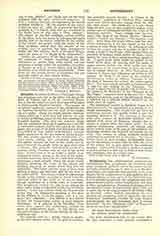

Antiphon, IN GREEK LITURGY. —The Greek Liturgy uses antiphons, not only in the Office, but also in the Mass, at Vespers, and at all the canonical Hours. Nor is this all; antiphons have their prescribed place in almost every liturgical function. The essence of antiphonal psalmody consists in the alternation set up between the soloists and the choir in the rendering of a psalm. About the fourth century, alternate singing which up to that time had been in use only in secular gatherings, found its way into meetings for liturgical worship. This does not, however, imply that the antiphonal chanting of psalms was a novelty in the fourth century, since it was used in the Synagogue, and it is not at all likely that the Church would have waited so long before assimilating a practice highly conducive to the due order of public prayer. The real novelty consisted in the introduction of a more ornate melody into antiphonal psalmody. The soloists chanted the text of the psalm, and at stated intervals the people broke in upon them with a refrain. The Apostolic Constitutions speak of a custom, which, Eusebius tells us, was in use in his time. It had come to be no longer a matter of an interjected refrain, foreign to the text of the psalm, or linked onto each verse, but of a very short ending, sometimes a mere syllable, which the whole people chanted, drowning the voices of the soloists and finishing the word or phrase which they had left unfinished. This latter method seems to have been general in Syria, and had been used by the Jews at an earlier period. The refrain, a kind of exclamation foreign to the context, recurring at stated intervals, consisted either of one word, or of two or three, though sometimes of a whole verse or troparium. This antiphonal method was also in use among the Jews, and is easily recognizable in the case of certain psalms. It was this method which the Church took as her own. St. Athanasius, speaking of the place of the Alleluia (q.v.) in the psalms, calls it a “refrain” or a “response.” The Alleluia is, as a matter of fact, the interjectional refrain of most frequent occurrence. It is referred to by Tertullian, from whose time onward this exclamation retains its place in ecclesiastical chant. In the Syrian and Egyptian liturgies of the fourth century its role is a prominent one.
The formula used as a refrain varied in length, as has been already stated, but the general tendency was probably towards brevity. A “Canon of the Antiphons”, published by Cardinal Pitra, includes some very concise formulas, among which the Alleluia often recurs. The others are, as a rule, drawn from the first verse of their respective psalms, while similar ones are interjected between the verses of the Scripture canticles. These endings may be compared with those of the Roman litanies: “Miserere nobis”, “Exaudi nos, Domine”, “Te rogamus, audi nos”. Even when the longer refrain took the place of the exclamation, it did not exceed at the most, a phrase of some fifteen words, St. Athanasius tells us that the custom was due to a desire to allow the people a share in the liturgy, while sparing them the necessity of learning whole psalms by heart, which, indeed, the mass of them would have been unable to do. A great many texts might be quoted in the Greek world alone, all showing that the reader or singer (cantor) recited the whole psalm, but that the response of the crowd broke in upon the recitation at regular intervals. St. John Chrysostom, St. Gregory of Nyssa, and Callimicus, all testify to this custom. St. Basil, in his letter to the faithful of Neo-Caesaraea, writes as follows: “Leaving to one the duty of intoning the melody, the others answer him.” The same custom prevailed at Constantinople in 536 for the singing of the Trisagion. Nor should a signal instance be passed over in silence, i.e. the hymn of St. Methodius in his “Banquet of the Ten Virgins”, composed prior to the year 311. Each alphabetical strophe sung by the bridesmaid, Thecla, is followed by a uniform refrain, rendered by the whole choir of virgins.
The antiphonal system is, therefore, found to be characterized by the interjection of a refrain, or of a simple exclamation. This system did not alter the customary method, but merely added a new and accessory element to it. The structure of the antiphon thus consists of hymn-like strophes, interspersed with verses of Scripture, whereas the response is drawn from the psalm itself. In the psalmus responsorius, moreover, all present take up the refrain, while in the case of the antiphon, the hymn-like strophes are rendered alternately by the choir. The custom of calling alternate psalmody antiphonal is probably due to this fact. The hymn-‘ writers found in these strophes inexhaustible material for elaboration, so that, little by little, the verses of the psalms had to give place to the additional strophes. There exist examples of psalms or groups of psalms reduced in this way to three or four verses, and sometimes, even to a single verse.
H. LECLERCQ

